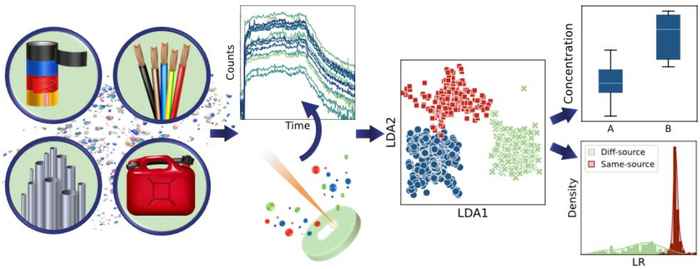How to link plastics found at a crime scene to potential suspects
4 April 2024
The paper constitutes an important step in the development of a validated model that can be used in court cases. It would, for instance, link a piece of duct tape found at a crime scene to a tape roll found at a suspect's home. Or it could establish what brand of tape was used.

LA-ICP-MS or ‘laser ablation-inductively coupled plasma-mass spectrometry’ is an analytical method that is sensitive, selective, minimally destructive, and requires little sample preparation. In earlier research, De Bruin-Hoegée already established its potential for forensic elemental profiling of plastics. LA-ICP-MS currently is the most suitable method for forensic plastics profiling. X-ray fluorescence (XRF) is considerably less sensitive and infrared spectroscopy (IR) or isotope ratio mass spectrometry (IRMS) provide a less specific profile.
Calculating likelihood ratios
In the study now published in Forensic Chemistry, the research team examined large datasets of plastic objects: tapes, electrical wires, tubing, and jerrycans using LA-ICP-MS. They then applied different machine learning models and compared them with traditional statistical methods to improve the classification and comparison of polymer evidence.
The study enables the calculation of likelihood ratios that represent the probability of the evidence. They are calculated by dividing the probability that samples originate from the same source by the probability that they are from different sources. This can be used to quantify the possible connection between a material found at the crime scene and evidence confiscated from a suspect, or reference data.
The research is part of the Forensic Attribution for CWA INtelliGence (FACING) project, a collaboration between the Van 't Hoff Institute for Molecular Sciences (HIMS) of the University of Amsterdam and TNO Defence, Safety & Security. The research was performed in collaboration with the National Institute of Standards and Technology (NIST, United States) and the Netherlands Forensic Institute (NFI, The Netherlands). The FACING project is financed by the Dutch Ministry of Defence
Abstract of the paper
LA-ICP-MS is a powerful technique for obtaining a forensic elemental profile of polymer evidence materials. However, the lack of homogeneous polymer reference standards hampers database creation and reliably matching a sample to a specific source. Therefore, the current study aims to evaluate the strength of evidence of forensic polymer comparisons by applying a matrix-matched reference standard with known concentrations for elements of interest. Four datasets of tapes, electrical wires, tubing, and jerrycans were compiled using LA-ICP-MS. It was found that quantification with the new PVC standard or by simply using the response of one element as internal standard significantly reduced the between-run variation. For each class of polymeric materials, characteristic elements could be identified with PCA and LDA. To facilitate classification, elemental concentrations were found to be typical for specific colors and types of polymeric materials. For forensic comparison, a score-based Bayesian likelihood ratio model and the t-test overlap method performed better than the feature-based model and 4-sigma criterion, in terms of rates of misleading evidence. Normalization to 13C and quantification with the PVC standard with and without prior normalization to 13C slightly reduced rates of misleading evidence. The t-test method showed an overall average false inclusion rate of only 0.45% and a false exclusion rate of 2.4%. Maximum calibrated likelihood ratios of 0.014 to 1778 were found for the tape dataset. In conclusion, this study demonstrates that with the use of proper standards, quantitative elemental profiling with LA-ICP-MS is a promising tool for forensic classification and comparison of polymers.
Paper details
Mirjam de Bruin-Hoegée, Ruthmara Corzo, Peter D. Zoon, Peter Vergeer, Jorien Schoor, Marcel J. van der Schans, Daan Noort, Arian C. van Asten: Evaluating the strength of evidence of elemental profiling of polymers with LA-ICP-MS. Forensic Chemistry 38 (2024) 100570. DOI: 10.1016/j.forc.2024.100570
See also
- Research website of Mirjam de Bruin – Hoegée: Forensicscientist.nl
- FACING project